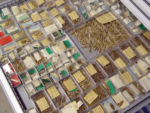Clausilids
Clausilids are small-size land snails that are alos known as door snails. The tests of most species are only several millimeters hight. Very few specimens exceed a length of 2 cm. Clausilids prefer humid places, for example wet logs, rocks or garden walls. This is why it is most likely to observe these gastropods very early in the morning or after rain. Their small, tower-like shell enables clausilids to hide in the finest cracks in rock, in the bark or in the foliage during periods of dry weather. Clausilids feed upon grazing algae.
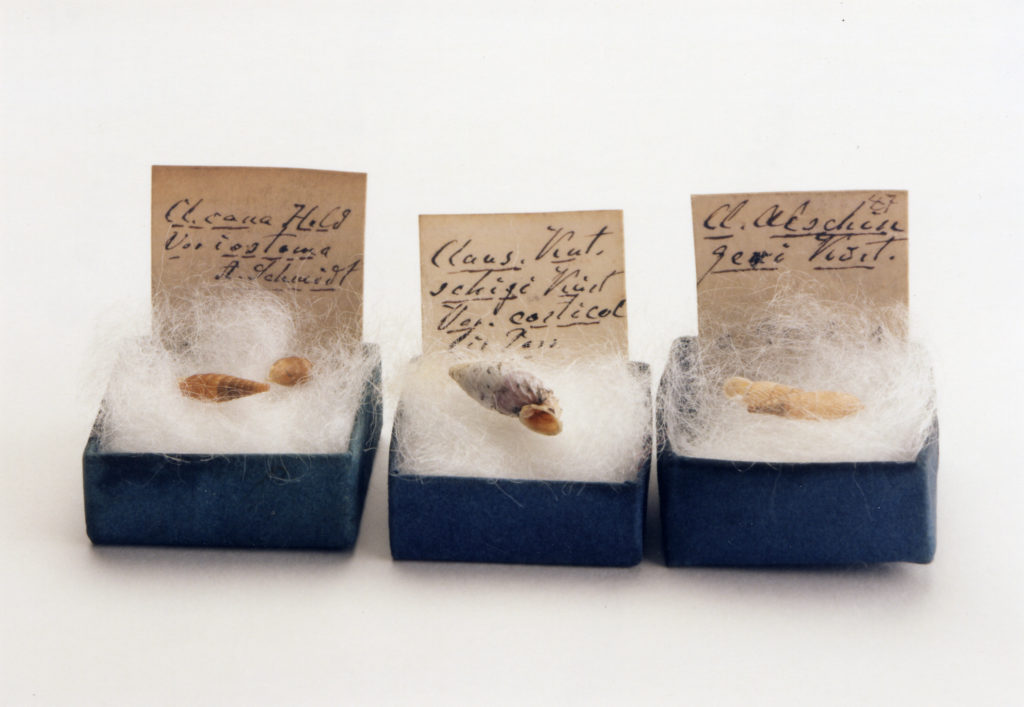
Like almost all land snails door snails are hermaphrodites. Even for laymen clausilids are easy to distinguish from other gastropods since most of the species show left-winded shells. The name originates from a spoon-shaped calcareous plate, the clausilium, that is located at the aperture of the animal. This plate closes the shell, but the gastropod is able to push the cap on the inside of the shell by an elastic appendix to stretch its body out of the aperture.
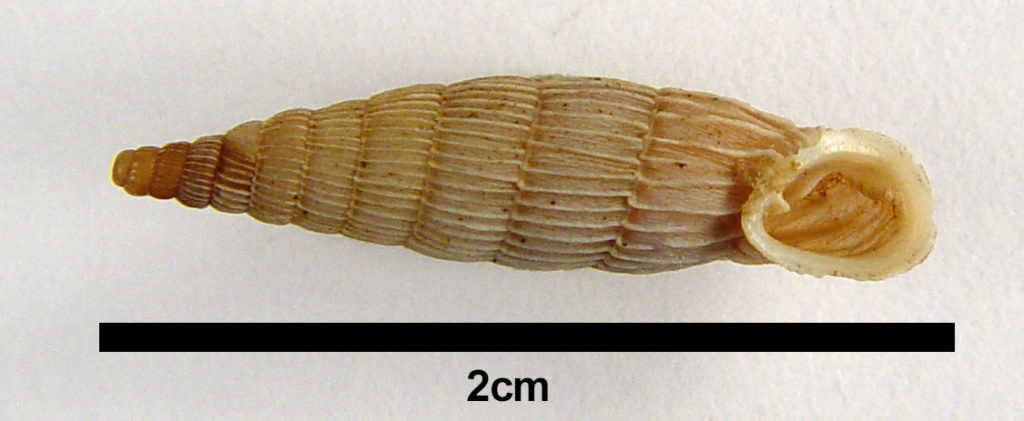
The clausilids of the Geosciences Collection were collected mainly by two people, Bernhard Schmacker and Dr. Gerhard von dem Busch. Their material was mainly accumulated between the mid and the end of the last but one century.
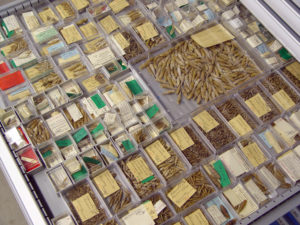
Clausilids of the collections of von dem Busch and Schmacker
There are 2000 entries of clausilids in the data base, this is all of the existing material. This number stands for several thousand specimens, since there is much more than one specimen hidden behind a single data entry.
Door shells mainly occur in the Balkan, in Greece, Turkey and Caucasia. This is partly reflected in the chart comprising a small part of the collection. However, this selection is random and cannot include the depth of localities and diversity of species. The clausilid material of the Geosciences Collection, in particular that collected by Dr. Gerhard von dem Busch, does not come from the main area of distribution, but from all over the world. This international aspect is one point in making up the eminent value and matchlessness of the collection. The countries of origin include for example Afghanistan, Australia, Burma, China, the Himalaya, India, Indonesia, Jamaica, Cuba, New Zealand, Taiwan, Tanzania, Vietnam and the United States.
Clausilids are supposed to be typical of south eastern Europe, however, most of the material in the collection comes from Asia. This can be explained by the intensive collecting activities of Schmacker, who lived in eastern Asia as a tradesman for decades and who collected gastropods in his leisure time.
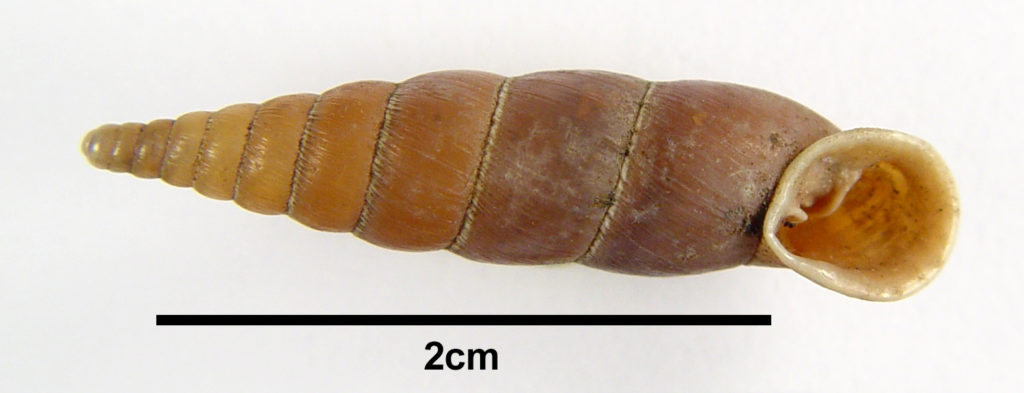
The following chart presents some data of snails of the family Clausiliidae that are represented in the Geosciences Collection.
| Species | Country | Locality/region | Collector |
| Albinaria caerulea | China | San-tu, Kiangsi | Schmacker |
| Albinaria doertleri | Cypress | Kophinou, Troodos | Oberwimmer |
| Albinaria thiesseana | Greece | Pátrai (Patras), Peloppones | Schmacker |
| Alpoia straminicollis | Romania | Bucsecs | Schmacker |
| Alopia bogatensis | Romania | Krizpa | Schmacker |
| Balea glauca | Iran | Chukak | von dem Busch |
| Clausilia loczyi | Vietnam | Tong King | Schmacker |
| Clausilia phalerata | Poland | Alpe Stoczek | Jantzen |
| Delima (Montenegrina) cattaroensis | Yugoslavia | Cattaro (Kotor), Montenegro | Oberwimmer |
| Delima ornata | Italy | Lake Comer, Lombardia | von dem Busch |
| Euphaedusa faberi | Japan | Omi-shima, close to Yamaguchi | Schmacker |
| Euphaedusa nigricans | Germany | Thuringia | von dem Busch |
| Euxina pumiliformis | Russia | Mount Chugush, Caucasia | Schmacker |
| Gracilaria filograna | Italy | Triest | Schmacker |
| Idyla (I.) bicristata | Greece | Olymp | von dem Busch |
| Idyla kephissiae | Greece | Attica | von dem Busch |
| Iphygena bidentata | Turkey | Marmara islands | Schröder |
| Iphigena concilians | Hungary | Szabolcs | von dem Busch |
| Iphigena lineolata | Germany | Bavaria | von dem Busch |
| Iphigena lineolata | Italy | Mte Zebio, Venetien | Oberwimmer |
| Iphigena plicatula | Germany | Bielefeld, Northrhine-Westphalia | Schröder |
| Lacinaria (Strigilecula) cana | Germany | Bavaria | von dem Busch |
| Medora kutschigii | Croatia | Brezcia, Dalmatien | von dem Busch |
| Papillifera solida | Lebanon | Beirut | Schmacker |
| Phaedusa acoidula | Russia | Caucasia | von dem Busch |
| Phaedusa corpulenta | Croatia | Brezcia, Dalmatien | von dem Busch |
| Phaedusa corticina | Croatia | Dalmatia | von dem Busch |
| Phaedusa elata | Romania/ Ukraina |
Bukowina | von dem Busch |
| Phaedusa gastrolepta | Croatia | Dalmatia | von dem Busch |
| Phaedusa pachygastris | Italy | Torre de Meloria | von dem Busch |
| Phaedusa saxatiles | Germany | Lake Zwischenahn, Lower Saxony | von dem Busch |
| Phaedusa senilis | Greece | Korfu | von dem Busch |
| Phaedusa succinata | Romania | Carpathians | von dem Busch |
| Phaedusa viridana | Syria | Muhajjah | von dem Busch |
| Pirostoma densestriata | Austria | Alps | von dem Busch |
| Prosopeas (P.) erectus | China | Hongkong | Schmacker |
| Selenoptyx inversiluna | Japan | Nago, Okinawa | Loosjes |
| Tropidauchenia orientalis | Indonesia | Java | von dem Busch |
References
- Borcherding, F. (1901): Diagnosen neuer Achatinellen-Formen von der Sandwichinsel Molokai. – Nachrichtsblatt der Deutschen Malakologischen Gesellschaft 1901: 52-58.
- – (1910): Monographie der auf den Sandwichinsel Kauai lebenden Molluskengattung Carelia. – Abhandlungen der Senckenbergischen Gesellschaft 32: 225-251.
- Kuster-Wendenburg, E. (1999): Der Bremer Stein und die Dinosaurier. Die Geschichte einer Sammlung. – 95; Aschenbeck & Holstein, Bremen.



